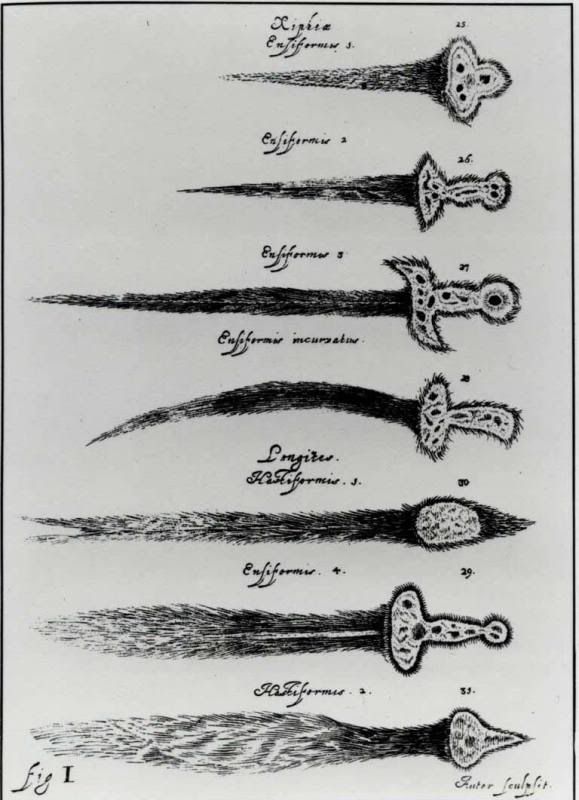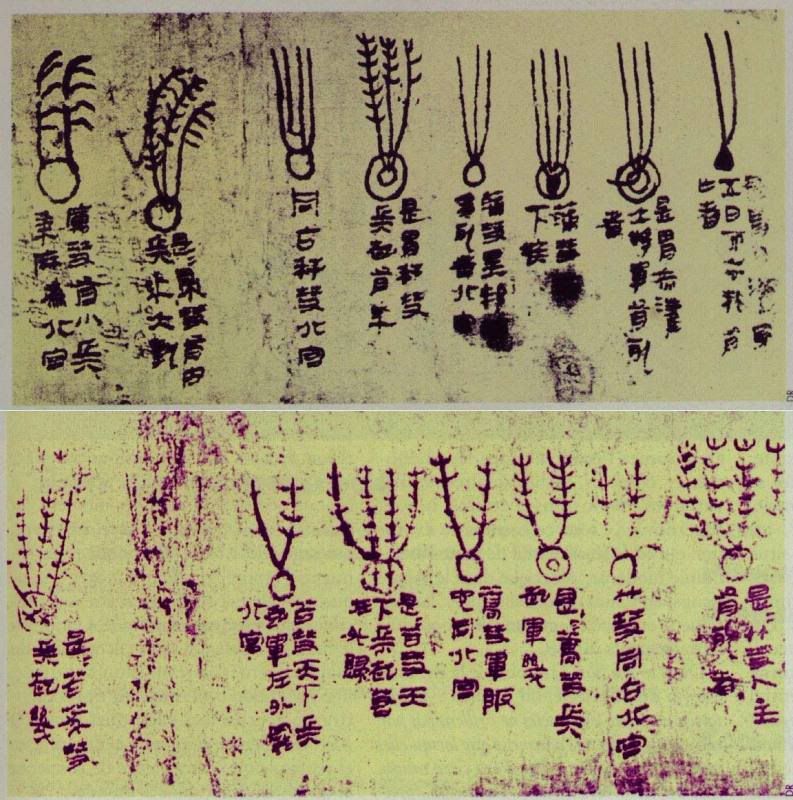You are here
Cataclysmic Collision between Planet-like Bodies.2009
Primary tabs
| Size | Seeds | Peers | Completed |
|---|---|---|---|
| 202.32 MiB | 0 | 0 | 0 |
This is a TORRENT File
how to download a torrent:
http://www.wikihow.com/Download-Torrents
you will need to sign up at http://tracker.conspiracycentral.net
to download this file!!!
*********************************************************************
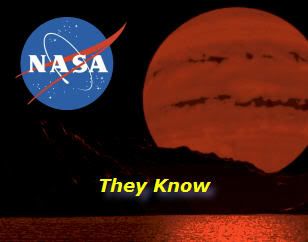
NASA.Evidence of a Cataclysmic Collision between Planet-like Bodies.2009
+ NASA Spacecraft Reveals Mysterious Object Punching Through One Of Saturn's Rings
------------------------------------------------------------------------->
Have you ever wondered where the moon came from?
Have you ever contemplated how the asteroid belt Came to be?
These are basic things to WONDER about!! We need everyone’s help!! Do your part!!
When the student is ready, the teacher will present one’s self.
Come help us figure this mystery OUT!!!!
No matter what your color or belief or age, YOU can be a scientist!!
Challenge yourself, your peers, your teachers. Participate in a revolution in science!!
UNDERSTAND, IT IS YOUR WORLD!!! & TOGETHER we can Figure it OUT!!!
When WE all UNDERSTAND HOW MUCH WE ARE THE SAME,
TRUE POSITIVE things happen all around YOU!!!
Your Children, (ARE) Tomorrow's LEADERS!!!-------------->>>>>>>>>>>>
------------------------------------------------------------------------->
These are for Planet X, Precession & Pole/Magnetic Reversal research ONLY!
NOT!! Religious debate!! Your faith is your OWN BUSINESS!!
We are here for Research ONLY!!
If you have an open mind, you will GO far!!!
------------------------------------------------------------------------->
---->>> includes:
Evidence of a Cataclysmic Collision between Planet-like Bodies.2009.DOCX
+ Planet Smash-Up Animation NASA JPL Spitzer Space Telescope HD.V-Animation_Sorenson 3.mov
NASA Spacecraft Reveals Mysterious Object Punching Through One Of Saturn's Rings.DOCX
& other random clips!!!
Evidence of a Cataclysmic Collision between Planet-like Bodies.2009
http://www.newscientist.com/articlevideo/dn17587/33352621001-planetary-s...
PASADENA, Calif. -- NASA's Spitzer Space Telescope has found evidence of a high-speed collision between two burgeoning planets around a young star.
Astronomers say that two rocky bodies, one as least as big as our moon and the other at least as big as Mercury, slammed into each other within the last few thousand years or so -- not long ago by cosmic standards. The impact destroyed the smaller body, vaporizing huge amounts of rock and flinging massive plumes of hot lava into space. An artist's animation of the event is at http://www.nasa.gov/mission_pages/spitzer/multimedia/spitzer-20090810.html .
Spitzer's infrared detectors were able to pick up the signatures of the vaporized rock, along with pieces of refrozen lava, called tektites.
"This collision had to be huge and incredibly high-speed for rock to have been vaporized and melted," said Carey M. Lisse of the Johns Hopkins University Applied Physics Laboratory, Laurel, Md., lead author of a new paper describing the findings in the Aug. 20 issue of the Astrophysical Journal. "This is a really rare and short-lived event, critical in the formation of Earth-like planets and moons. We're lucky to have witnessed one not long after it happened."
Lisse and his colleagues say the cosmic crash is similar to the one that formed our moon more than 4 billion years ago, when a body the size of Mars rammed into Earth.
"The collision that formed our moon would have been tremendous, enough to melt the surface of Earth," said co-author Geoff Bryden of NASA's Jet Propulsion Laboratory, Pasadena, Calif. "Debris from the collision most likely settled into a disk around Earth that eventually coalesced to make the moon. This is about the same scale of impact we're seeing with Spitzer -- we don't know if a moon will form or not, but we know a large rocky body's surface was red hot, warped and melted."
Our solar system's early history is rich with similar tales of destruction. Giant impacts are thought to have stripped Mercury of its outer crust, tipped Uranus on its side and spun Venus backward, to name a few examples. Such violence is a routine aspect of planet building. Rocky planets form and grow in size by colliding and sticking together, merging their cores and shedding some of their surfaces. Though things have settled down in our solar system today, impacts still occur, as was observed last month after a small space object crashed into Jupiter.
Lisse and his team observed a star called HD 172555, which is about 12 million years old and located about 100 light-years away in the far southern constellation Pavo, or the Peacock (for comparison, our solar system is 4.5 billion years old). The astronomers used an instrument on Spitzer, called a spectrograph, to break apart the star's light and look for fingerprints of chemicals, in what is called a spectrum. What they found was very strange. "I had never seen anything like this before," said Lisse. "The spectrum was very unusual."
After careful analysis, the researchers identified lots of amorphous silica, or essentially melted glass. Silica can be found on Earth in obsidian rocks and tektites. Obsidian is black, shiny volcanic glass. Tektites are hardened chunks of lava that are thought to form when meteorites hit Earth.
Large quantities of orbiting silicon monoxide gas were also detected, created when much of the rock was vaporized. In addition, the astronomers found rocky rubble that was probably flung out from the planetary wreck.
The mass of the dust and gas observed suggests the combined mass of the two charging bodies was more than twice that of our moon.
Their speed must have been tremendous as well -- the two bodies would have to have been traveling at a velocity relative to each other of at least 10 kilometers per second (about 22,400 miles per hour) before the collision.
Spitzer has witnessed the dusty aftermath of large asteroidal impacts before, but did not find evidence for the same type of violence -- melted and vaporized rock sprayed everywhere. Instead, large amounts of dust, gravel, and boulder-sized rubble were observed, indicating the collisions might have been slower-paced. "Almost all large impacts are like stately, slow-moving Titanic-versus-the-iceberg collisions, whereas this one must have been a huge fiery blast, over in the blink of an eye and full of fury," said Lisse.
Other authors include C.H. Chen of the Space Telescope Science Institute, Baltimore, Md.; M.C. Wyatt of the University of Cambridge, England; A. Morlok of the Open University, London, England; I. Song of The University of Georgia, Athens, Ga.; and P. Sheehan of the University of Rochester, N.Y.
JPL manages the Spitzer mission for NASA's Science Mission Directorate, Washington. Science operations are conducted at the Spitzer Science Center at the California Institute of Technology in Pasadena. Caltech manages JPL for NASA. Spitzer's infrared spectrograph, which made the observations in 2004 before the telescope began its "warm" mission, was built by Cornell University, Ithaca, N.Y. Its development was led by Jim Houck of Cornell.
For more information about Spitzer, visit http://www.spitzer.caltech.edu/spitzer and http://www.nasa.gov/spitzer . More information about NASA's planet-finding program is at http://planetquest.jpl.nasa.gov .
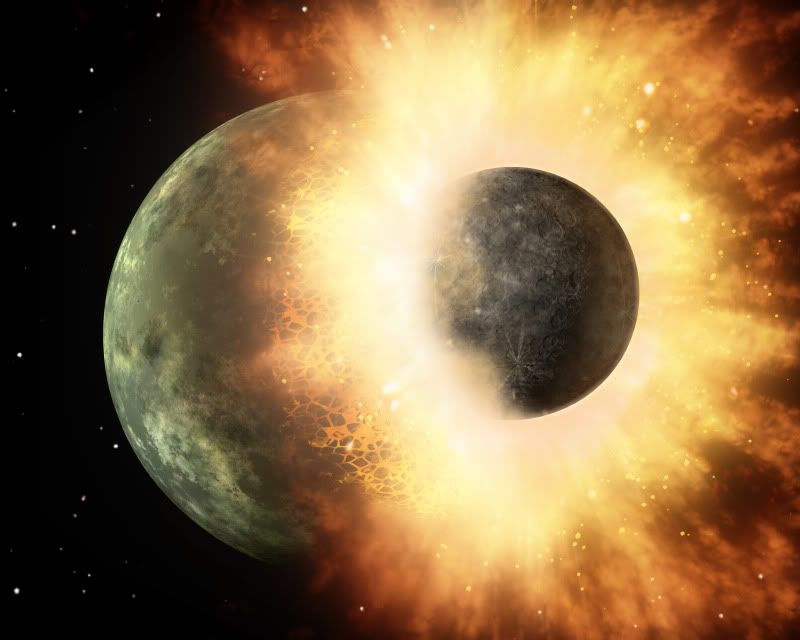
This artist's concept shows a celestial body about the size of our moon slamming at great speed into a body the size of Mercury. NASA's Spitzer Space Telescope found evidence that a high-speed collision of this sort occurred a few thousand years ago around a young star, called HD 172555, still in the early stages of planet formation. The star is about 100 light-years from Earth.
Spitzer detected the signatures of vaporized and melted rock, in addition to rubble, all flung out from the giant impact. Further evidence from the infrared telescope shows that these two bodies must have been traveling at a velocity relative to each other of at least 10 kilometers per second (about 22,400 miles per hour).
As the bodies slammed into each other, a huge flash of light would have been emitted. Rocky surfaces were vaporized and melted, and hot matter was sprayed everywhere. Spitzer detected the vaporized rock in the form of silicon monoxide gas, and the melted rock as a glassy substance called obsidian. On Earth, silica can be found around volcanoes in black glassy rocks called obsidian, and around meteor craters in small rocks called tektites.
Shock waves from the collision would have traveled through the planet, throwing rocky rubble into space. Spitzer also detected the signatures of this rubble.
In the end, the larger planet is left skinned, stripped of its outer layers. The core of the smaller body and most of its surface were absorbed by the larger one. This merging of rocky bodies is how planets like Earth are thought to form.
Astronomers say a similar type of event stripped Mercury of its crust early on in the formation of our solar system, flinging the removed material away from Mercury, out into space and into the sun. Our moon was also formed by this type of high-speed impact: a body the size of Mars is thought to have slammed into a young Earth about 30 to 100 million years after the sun formed. The sun is now 4.5 billion years old. According to this theory, the resulting molten rock, vapor and shattered debris mixed with debris from Earth to form a ring around our planet. Over time, this debris coalesced to make the moon.
Image credit: NASA/JPL-Caltech

A vast mess of frozen lava and vaporised rock has been found orbiting a nearby star, evidence of a cataclysmic collision between planet-like bodies outside our solar system. Such collisions are thought to have created Earth's moon and left other scars in the solar system, but it's not yet clear how common they are around other stars.

Hints of past violent collisions abound in our solar system. Many suspect the moon formed from the debris created when a Mars-sized object smashed into the Earth. Other smashups may have pulled offMovie Camera most of Mercury's crust, tilted Uranus on its side, and caused Venus to spin backwards.
Now a team has found evidence of an intense impact surrounding the star HD 172555, which sits some 100 light years away in the southern constellation Pavo, or Peacock.
This is the first time materials like volcanic glass and vaporised rock have been found orbiting a young star that is old enough to have formed planets, says Carey Lisse of Johns Hopkins University in Laurel, Maryland. The star is 12 million years old.

Preliminary evidence also suggests two other stars show similar hints of cataclysmic impacts, Lisse says. "We're now trying to figure out whether we've found a new class of rare but very exciting systems," Lisse told New Scientist.
Volcanic glass
Lisse and colleagues examined the spectrum of HD 172555's infrared light, captured with NASA's orbiting Spitzer Space Telescope. Bumps and dips in the spectrum can reveal the chemical composition of the star as well as the object that surround it, and the team found two unusual features.
One peak matched up with volcanic, silica-based glasses. This material is similar to obsidian, a dark glass created in volcanic eruptions, and tektites, cooled chunks created when liquid rock is ejected during impacts, cooling and hardening in flight.
Another peak revealed large quantities of silicon monoxide gas – a byproduct of vaporised rock. The team also found a vast amount of cold, dark dust and rubble.
The total amount of debris adds up to a mass between that of Pluto and the moon, and points to a cataclysmic impact in which two bodies slammed into each other at a relative speed of at least 10 kilometres per second. But it is difficult to say for sure what sorts of bodies might be responsible for the collision.
A smashup sometime in the last million years between two large rocky bodies, each perhaps rivalling the size of Mercury or the moon, might explain the debris.
Other moons?
Studying systems that have suffered large collisions could reveal more about how the solar system formed, says George Rieke of the University of Arizona in Tucson, who was not affiliated with the study.
"The interesting science twist is that we are actually finding traces of the kinds of major collisions that we think shaped the Earth-moon system," Rieke says.
But it is not clear whether the collision around HD 172555 created debris that would have coalesced into an object like the moon. "This could just mean that two things smashed each other to smithereens," Rieke told New Scientist.
The fact that only a few stars have so far shown evidence of a violent collision, even though hundreds seem to be surrounded by dusty discs, suggests the violent impacts that seem to have shaped our solar system might be fairly rareMovie Camera. "It implies at some level moons like ours may be pretty uncommon," Rieke says.

NASA Spacecraft Reveals Mysterious Object Punching Through One Of Saturn's Rings
What is going on with Saturn's rings? It appears that recent images from NASA's Cassini spacecraft reveal what seems to be a small object that has ripped through one of the planet's otherwise flat rings. The purpose of the NASA mission, the BBC explains, was to observe "an equinox on Saturn, in a bid to learn more about the gas giant's ring system."
Cassini spotted the "moonlet" in Saturn's B ring
Planetary scientists are keenly observing an equinox on Saturn on 11 August, in a bid to learn more about the gas giant's ring system.
A planet's equinox comes twice a year when the Sun crosses its equator, making day and night the same length.
It takes Saturn nearly 30 Earth years to orbit the Sun, so this is the first equinox since 1994.
Around equinox, irregularities show as long shadows on the otherwise flat surface of the rings.
Objects such as "moonlets" - very small natural satellites, which are often difficult to spot - become easy to detect.
Tiny discovery
Last week, the shadows revealed a new moonlet in Saturn's B ring.
The shadows have been cast at equinox for millennia. But for the first time there is a witness in the shape of Nasa's Cassini spacecraft, which spotted the new object.
This moonlet is about 480km (300 miles) from the outer edge of the B ring.
Nasa says that the size of the shadow means the moonlet protrudes about 200m (660ft) from the ring plane. If it is orbiting in the same plane as the ring material surrounding it, which seems likely, it must be about 400m (1,300ft) across.
At the moment of equinox, the rings turn edge-on to the Sun and reflect almost no sunlight.
"Whenever equinox occurs on Saturn, sunlight will hit Saturn's thin rings, the ring plane, edge-on," said Linda Spilker from Nasa's Jet Propulsion Laboratory in Pasadena.
"The light reflecting off this extremely narrow band is so small that for all intents and purposes the rings simply vanish."
Cassini was launched in October 1997 from Florida's Cape Canaveral Air Force Station. It arrived at Saturn in 2004 to embark on a four-year mission of exploration around the planet and its moons.
The spacecraft it still operating well and has been re-programmed to carry out new tasks. It will now aim to answer some of the questions raised by its earlier observations.
Punching through the F Ring
This image, taken as Saturn approaches its August 2009 equinox, shows a shadow being cast by a narrow, vertically extended feature in the F ring.
Imaging scientists are working to understand the origin of structures such as this one, but they think this image may show the shadow of an object on an inclined orbit which has punched through the F ring and dragged material along in its path.
The second (bottom) version of the image has been brightened to enhance the visibility of the ring and shadow. Background stars appear elongated in the image because of the camera's exposure time.
This image and others like it (see PIA11663) are only possible around the time of Saturn's equinox which occurs every half-Saturn-year (equivalent to about 15 Earth years). The illumination geometry that accompanies equinox lowers the sun's angle to the ringplane and causes out-of-plane structures to cast long shadows across the rings. Cassini's cameras have spotted not only the predictable shadows of some of Saturn's moons (see PIA11657), but also the shadows of newly revealed vertical structures in the rings themselves (see PIA11654).
This view looks toward the unilluminated side of the rings from about 27 degrees above the ringplane.
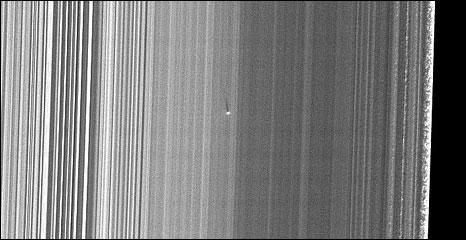
The image was taken in visible light with the Cassini spacecraft narrow-angle camera on June 11, 2009. The view was acquired at a distance of approximately 866,000 kilometers (538,000 miles) from Saturn and at a Sun-Saturn-spacecraft, or phase, angle of 30 degrees. Image scale is 5 kilometers (3 miles) per pixel.
The Cassini Equinox Mission is a joint United States and European endeavor. The Jet Propulsion Laboratory, a division of the California Institute of Technology in Pasadena, manages the mission for NASA's Science Mission Directorate, Washington, D.C. The Cassini orbiter was designed, developed and assembled at JPL. The imaging team consists of scientists from the US, England, France, and Germany. The imaging operations center and team lead (Dr. C. Porco) are based at the Space Science Institute in Boulder, Colo.
For more information about the Cassini Equinox Mission visit http://ciclops.org, http://www.nasa.gov/cassini and http://saturn.jpl.nasa.gov.
Credit: NASA/JPL/Space Science Institute
Released: August 7, 2009 (PIA 11662)
Image/Caption Information
http://ciclops.org/view/5683/Punching_through_the_F_Ring
------------------------------------------------------------------------->
AUDIO:
Drum & Bass / Jungle / Hiphop
Red Mist Radio August 3rd 2009 - hosted by DJ Haze.mp3
------------------------------------------------------------------------->
SEED YE SALTY DOGS SEED!! DONT HIT N RUN YE DARN PIRATES
AND SAY THANKS IF YA LIKE IT!
Runnin-RED..Forward......WE flex for Planet X
Runnin-RED..Forward......WE flex for Planet X
Mindscape-Planet X
Drum&Bass (SONG) Come listen: http://www.bassdrive.com/v2/
------------------------------------------------------------------------->
These are for Planet X, Precession & Pole/Magnetic Reversal research ONLY!
NOT!! Religious debate!! Your faith is your OWN BUSINESS!!
We are here for Research ONLY!!
If you have an open mind, you will GO far!!!
------------------------------------------------------------------------->
Much Thanks to all the People Who took the tedious time and patience to create all this INFO/Pics & Research Material!!
Much thanks to the original people who UP'd these!!! You who help Us on Our journeys!!
We WANT to:
Gather and cross-check vast amounts of knowledge in many dozen specialized fields from scientists and researchers around the globe in addition to studying hundreds of historical documents spanning back to the dawn of history. These fields include archeology, geology, astro, geo & quantum physics, ancient languages & civilizations, paleontology, ancient history, genetics and others.
Events shape our lives, even distant and dark ones. From the time I was a wee little one, I have stopped my fear of dark places. I pick up my torch and journey alone through darkened corridors leading down into bottomless caverns of events past. I stumble upon the remnants of an intricate puzzle, which I bring back with me, and in the quiet of my dreams, are assembled before me.
The turning of the stars bring a time when my secrets can give you immortality.
but when that time has passed, those fleeting minutes gone, the secret is worthless.
until once again the stars unlock its power.
- Log in to post comments

